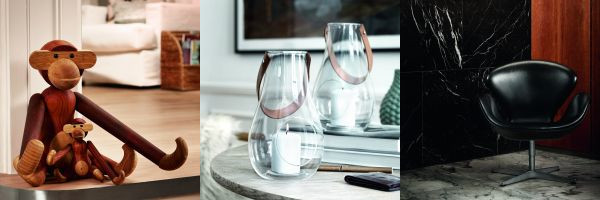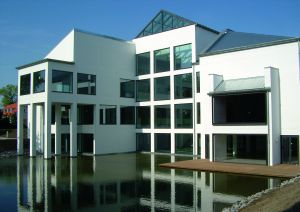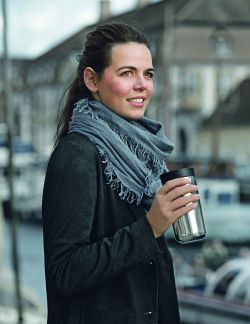A timeless, yet at the same time unmistakable style characterised by simplicity and functionality is what has made Danish architects and designers famous all over the world. Products “designed in Denmark” are also very popular in the haptic advertising sector. Eppi magazine spoke with representatives of famous designer brands about Danish design’s recipe for success.

Whether architecture or designing public spaces, whether designer bicycles or department stores for designer items – from breath-taking Illums Bolighus to the discounter Søstrene Grene – whether Arne Jacobsen’s Egg Chair and Poul Henningsen’s Artichoke Lamp in the hotel lobby or Krenit bowls, Holmegaard glasses and Bang & Olufsen loudspeakers in the restaurant in the evening – world-renowned Danish design is omnipresent in its country of origin and most of the Danes have a sense for surrounding themselves with objects of high-quality design. For them cars aren’t a status symbol, but designer furniture certainly is.
“Danes live with Danish design, something that is often noticed by foreigners,” stated Mette Stagsted Larsen, Marketing Direktor of Stelton. The Copenhagen-based brand for household appliances and crockery launched its success story in 1967 with the Cylinda series designed by Arne Jacobsen. For Stagsted Larsen the high standing that design enjoys in Denmark has significantly contributed to its commercial success – together with good marketing – and sales strategies: “Denmark is a small country with a long tradition of international trade and exporting goods and so the different designer manufacturers have been present at fairs all over the world. At the same time, visitors have been attracted by a strong cluster of design companies to important fairs in Denmark where they have experienced Danish design – not only across the fairgrounds, but in the hotels and restaurants, public spaces, galleries and in peoples’ homes.” Danish design has long since conquered the world – whether in households or offices, on the retail or B2B market, as originals or copies. The unmistakable style that the designer scene in Denmark founded between the start and the middle of the 20th Century has in the meantime been copied and counterfeited thousands of times over.
Keep it simple
But what distinguishes this style, which in spite of its incredible subtleness always remains unmistakable? For Stagsted Larsen, Danish design stands for timelessness, simplicity and functionality, but also for innovation: “Danish design is a fusion of form and functionality. Based on traditional handicrafts and later on studies of the human body, the products are practical in everyday use and the aesthetic aspect means that they are durable in more than one sense and thus a pleasure to use year after year. The lines are sleek and simple and details are well-worked.”

Standing on the shoulders of famous architects: The building of the Rosendahl Design Group was developed by Kim Utzon – the son of Jørn Utzon, creator of the opera house in Sydney.
By pursuing the motto “Form follows function”, the Danish designers are in sync with best Bauhaus tradition. Overall the creations with which Arne Jacobsen, Hans J. Wegner, Finn Juhl, Poul Henningsen or Herbert Krenchel – to name just a few of the leading pioneers – motivated the iconic style language in the 1950s, were mostly not at all revolutionary, especially loud or daring and are definitely not exuberant – on the contrary: Their main feature was more the fact that they left as much out as possible. “There are few ‘pop-up designs’ in the Danish tradition that aim to achieve short-lived effects. Most of them are long-term because the style is minimalist and does without any frills,” commented Bente Fallinge, PR & Media Manager of the Rosendahl Design Group. “This simplicity is also found in other areas of Danish architecture and product designs – for example in the ‘Dogma’ film movement or ‘New Nordic cuisine’ that is characterised by its simplicity and regionality.” Many of the Danish design pioneers had originally completed an apprenticeship as a carpenter or stonemason and they created stable, well-thought out products of high-quality workmanship that were designed to last for years – a sustainable attitude that is ongoing until this very day.
Strong tradition
In this way, an unmistakable design language arose over the decades that is also reflected in the work of young, contemporary Danish designers. Fallinge: “There is a very strong Danish ‘design DNA’ today, which several generations have contributed towards and which stands on the shoulders of famous architects and designers.” In the case of the Rosendahl Design Group, this is literally true: At the impressive headquarters of the group in Hørsholm, North of Copenhagen, two generations were involved: The building was developed by architect Kim Utzon – the son of Jørn Utzon, the creator of the opera house in Sydney –, his sister Lin Utzon and her daughter Naja Utzon Popov have created impressive art pieces found in the building.
This is where the Rosendahl Design Group works with the design, marketing and worldwide sales of eight brands: Arne Jacobsen Clocks (wall and table clocks), Bjørn Wiinblad Denmark (porcelain), Global Knives (knives), Holmegaard (glass), Juna (household textiles), Kay Bojesen Denmark (wooden figures), Lyngby Porcelain (porcelain) and Rosendahl (products for the table, kitchen and home). “With the exception of the Japanese brand, Global, for whom we operate as the Northern agent in Denmark, Norway, Finland, Greenland and Iceland, we own all of the brand rights for the product areas we sell. This encompasses the in some cases extensive archive with products that that can inspire our designers in their work with old and new product lines,” explained Fallinge. “In this way, we can fall back on this valuable asset and where appropriate we try to revive ideas from the pool of products and further develop them.” The group has own designers employed, but also collaborates with external well-known designers, who provide drafts for the individual brands. Among them are famous names such as Maria Berntsen or Lin Utzon as well as newcomers. “We are often contacted by designers, who want to cooperate with us. The same applies for all of them: The designs have to match the brand,” stated Fallinge.
Carrying on and further developing tradition is the motto of the Stelton company, as Stagsted Larsen confirmed: “We wish to continue the Danish and Scandinavian design heritage. Not by dwelling in history and tradition for the sake of it, but by using it as a source of inspiration and to refine and develop it. Stelton works together with international designers and we strive to make our programme signify a new and innovative approach to product design within its respective category. We create products in a distinct quality – worthy of our proud history and tradition.”
Storytelling

Stelton’s To Go Click cup is a bestseller in the corporate communication area.
Many products don’t just carry history, but also stories in themselves – i.e. Kay Bojesen’s famous wooden animals among the line-up of the Rosendahl Design Group: “There is hardly a child in Denmark that hasn’t received a Bojesen monkey or one of his other figures as a gift somewhere along the line,” said Susanne Jönsson, International B2B Manager of the Rosendahl Design Group. “That is why adults also have a strong identification with this brand. Many of Bojesen’s ideas arose from a concrete experience like the hippopotamus with a moveable jaw that he designed because he needed a pen butler for his desk. Of course, marketing thrives on stories like these, which is why we use storytelling a lot, especially for the B2B market. A product is as good as sold if it has a good storyline.” Since its inception, the Rosendahl Design Group has been operating on the B2B market. “A great market that we are very active on,” reported Jönsson. “Due to their high quality, our products are of course often implemented as exclusive business gifts or premiums – i.e. in the scope of loyalty schemes.”
Special needs that the comprehensive B2B catalogues of the group take into account. However, own rules do apply in some cases in the business to business sector, as Jönsson added: “We try to provide ideas by presenting the products in theme worlds – a ‘Hygge theme’ with blankets, candle holders, vases and similar items is for example always part of the package. In contrast to the retail trade, where all of the brands are strictly separated, in the B2B area we combine together items that match, including products of different brands. Beyond this we also categorise the proposals for gifts according to price because, depending on the respective market, variable tax limitations apply: In Denmark the value threshold per recipient per year is 1,100 Danish Crowns (almost 150 Euros), in Germany for instance it is 35 Euros. Together with our partners from the promotional products trade we try to take such special features into account.”
Designing campaigns
Stelton also has a long tradition on the haptic advertising market: The products of Stelton are distributed worldwide through exclusive partnerships, retailers or gift distributors. “Quite naturally, the Scandinavian countries, Germany, UK and Switzerland are good markets. We are experiencing rising interest from Japan and China too and have very good B2B customers – hotels – in the Middle East,” reported Stagsted Larsen. “We have very successful collaborations with companies using our products as bonus and gift card gifts. These include our To Go Click cup and other products related to coffee, since the connection is obvious, but this is also possible in other fields. Stelton’s products are highly appreciated as Christmas gifts and we supply many large companies with ideas for gifts. Another segment is members’ clubs where we collaborate with leading German car manufacturers on products for their members’ shop. We also work with organisations and develop special products – this year, for example, a key ring for a Danish blood donor organisation that wants to thank their donors.”
Such custom-made designs are even possible where strict brand guidelines apply, as Jönsson explained: “We are often asked to what degree our products are individualisable or whether it is possible to have them designed to suit specific requirements. Of course we have to protect the brands, i.e. the heirs of the designers decide what is permitted and what isn’t. But there are always exceptions to the rule even for brands that are strictly regulated – for example we produced a Kay Bojesen bird once especially for a customer after obtaining the consent of Bojesen’s family.” In this way, design ideas arise that also on the corporate communications front contribute towards the world becoming a little more beautiful.
// Till Barth
photos: Rosendahl Design Group (4); Stelton (1)



